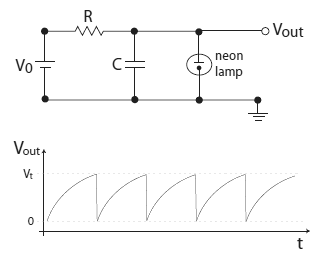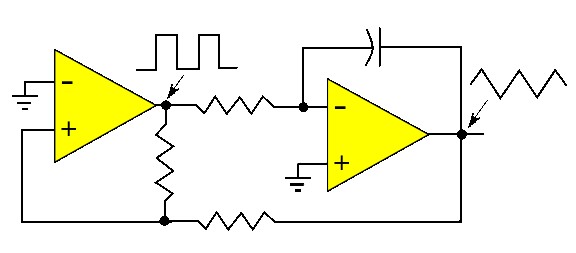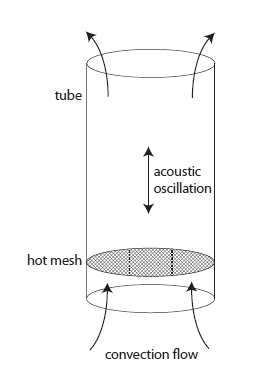Self-Oscillation
October 28, 2011
Oscillators are important devices in modern
electronics technology. You're likely reading this article on a
computer that's
clocked at two
gigahertz or higher. The
dual-core Linux system on which this article is being written runs at 2.66 GHz. The basic clock rate is established by a
quartz crystal resonator that oscillates at a lower frequency that is multiplied by a
phase-locked-loop.
Similar crystal oscillators are built into your
cellphone,
television,
cable box, and nearly every other electronic device in your house or automobile. Oscillators can be mechanical, also, such as
pendulum clocks. All these examples of oscillators are self-oscillators; that is, the energy source is not tuned to the resonator, but the resonator mechanism itself controls the
positive feedback, or restoring force, that keeps the oscillation going.
These self-oscillators are distinct from forced oscillators that are driven by an external energy source that's tuned to their resonant frequency.
Bowed and
wind musical instruments, and the
heartbeat, are all self-oscillators.
Alejandro Jenkins, a
physicist at
Florida State University (Tallahassee, FL) has just published a nice review of self-oscillation on the
arXiv Preprint Server.[1] One thing I found while reading his paper was that my physics education was incorrect in one regard. I was shown a film clip of the
Tacoma Narrows Bridge collapse and directed to the mainstay textbook of the era,
Resnick and Halliday, that said the cause was forced oscillation.
Jenkins sets the record straight that the bridge collapse was caused by self-oscillation. The bridge had a natural resonant frequency of 0.2 Hz, whereas the
Strouhal frequency of
turbulent vortex shedding for the 42 mph (68 km/h) winds would be 1 Hz. I can't be too critical of my
professors, one of whom was actually
Robert Resnick, since half of what I learned has become obsolete in the past forty years.
One fundamental example of a self-oscillator is the
Pearson-Anson relaxation oscillator, as shown in the figure. These were fun to build in the days when
neon bulbs were still plentiful, although we would use a
rectifier attached to the
household voltage supply rather than a
battery.

A Pearson-Anson relaxation oscillator using a neon bulb.
Fig. 8 of Ref. 1, via the
arXiv Preprint Server[1]
It can be seen from the
circuit that there is no resonant element. There's a
capacitor, but no
inductor, so its oscillating action is necessarily one of self-oscillation. The "circuitry" for the human heartbeat functions along the same principle.
Neon bulbs may be rare, but
operational amplifiers are ubiquitous, so we can give the example of a
triangle wave generator, as shown below. As in the relaxation oscillator, there is no resonant element in this circuitry.

Triangle wave generator using two operational amplifiers. The leftmost amplifier is wired as a comparator. The comparator supplies the driving force that enables the self-oscillation. One way to look at this force is as a "negative damping" component. (Circuit diagram by the author)
The equations of
damped harmonic motion are well developed. An example of such a
damped system is a pendulum with
friction at its pivot. Jenkins writes that one simple way to look at self-oscillation is as a system with negative damping.
Negative damping corresponds to an
in-phase force acting on an oscillator, which is an ideal way to keep the oscillation going.
Nonlinearities in the oscillator limit the
amplitude, which would grow
exponentially otherwise.
Jenkins also describes the operation of a
thermodynamic self-oscillator, the
Rijke tube, as shown in the figure. The device is so simple, I'm surprised that I've never seen a
science fair project using it.[2] A Rijke tube is a tube that's open at both ends, so air can flow through it. Low in the tube is an
electrically heated mesh. The mesh can be heated with a torch, but the
heat from the torch complicates matters. When the mesh is hot, an
acoustic tone is emitted by the tube,
The tone (an oscillation) is reinforced by the fact that the oscillating air column causes air to pass through the mesh in both directions, thereby enhancing the
heat transfer from the mesh to the air.

The Rijke tube thermodynamic self-oscillator.
Electrically heating the mesh will cause emission of an acoustic tone.
Fig. 12 of Ref. 1, via the arXiv Preprint Server[1]
![]()
References:
- Alejandro Jenkins, "Self-oscillation," arXiv Preprint Server, September 29, 2011
- Students can be quite imaginative in their science fair projects. I once viewed an elementary school science fair in which one project on sleep apnea had a most unusual display. There were several Barbie Dolls in tiny beds. The dolls had wires affixed to their heads. This was years before Robot Chicken.
Permanent Link to this article
Linked Keywords: Oscillator; electronics technology; computer; clock signal; gigahertz; multi-core processor; dual-core; Linux; quartz crystal resonator; phase-locked-loop; cellphone; television; cable box; pendulum clock; positive feedback; bowed string instrument; wind musical instrument; heartbeat; Alejandro Jenkins; physicist; Florida State University (Tallahassee, FL); arXiv Preprint Server; Tacoma Narrows Bridge; Resnick and Halliday; Strouhal frequency; turbulence; vortex shedding; professor; Robert Resnick; Pearson-Anson relaxation oscillator; neon bulb; rectifier; mains electricity; household voltage; battery; circuit; capacitor; inductor; operational amplifier; triangle wave; comparator; damped harmonic motion; damping; friction; in-phase; Nonlinearity; amplitude; exponential; thermodynamic; Rijke tube; science fair project; electrically heated; heat; acoustic; heat transfer; sleep apnea; Barbie Dolls; Robot Chicken.